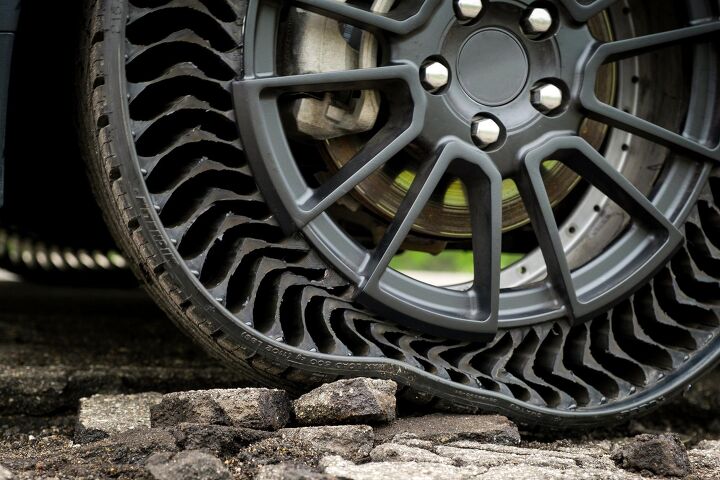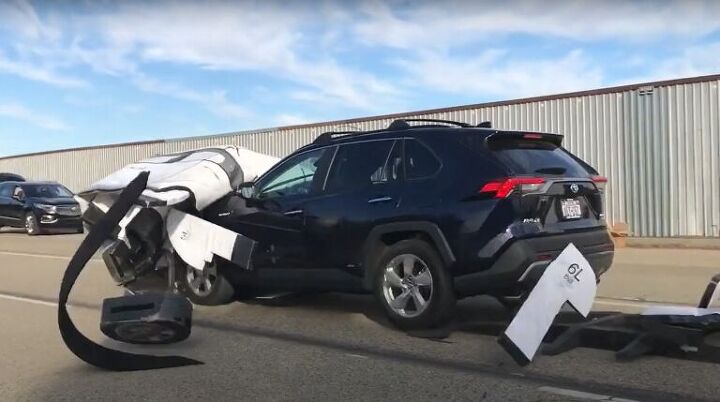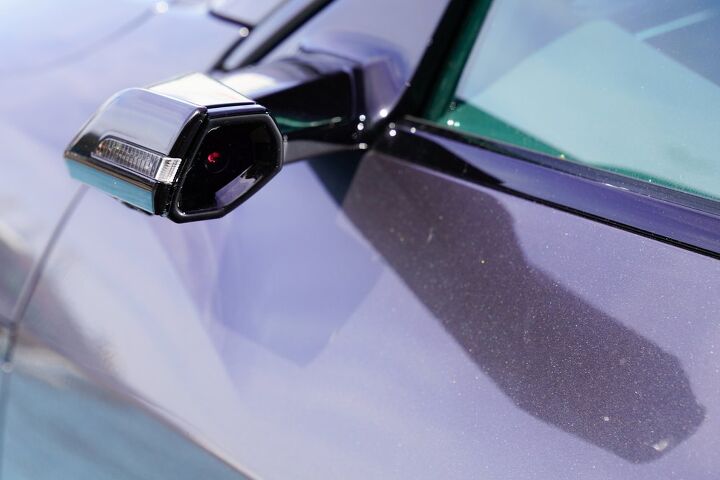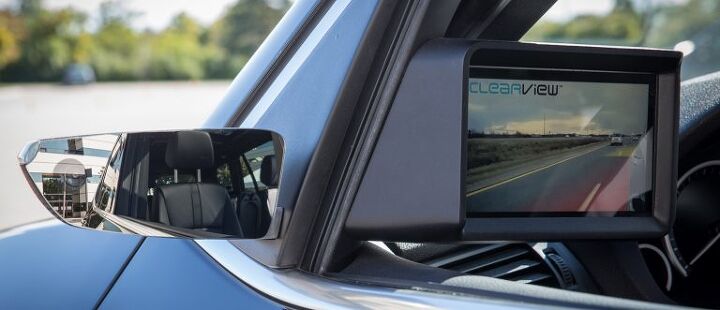#AutomotiveTechnology
Report: Michelin Airless Tires See Alleged Breakthrough
Airless tires are one of those concepts that have been around forever (we used to call them wagon wheels) but never seem to be able to achieve a technological breakthrough that would make them preferable to what’s already on the market. However, Michelin just managed to produce a set it says has been tested at 130 mph that it believes could be ideal for law-enforcement applications.
Rain or Shine: AAA Finds Out Advanced Driving Aids Still Suck
A new study from the American Automobile Association (AAA) has found that rain can severely impair advanced driver-assistance systems (ADAS). Similar to how highway traffic slows to a crawl when there’s a sudden deluge, modern safety equipment can have real trouble performing when a drizzle becomes a downpour.
On Thursday, the motor club organization released findings from closed-course testing that appeared to indicate some assistance suites had real trouble seeing through bad weather. AAA reported that 33 percent of test vehicles equipped with automatic emergency braking traveling collided with a stopped car when exposed to simulated rainfall at 35 mph. The numbers for automatic lane-keeping was worse, with 69 percent drifting outside the lines. Considering the number of times the people writing for this website have anecdotally criticized ADAS for misbehaving in snow, sleet, rain, fog, or just from an automobile being a little too dirty, it’s hard not to feel a little vindicated.
BMW Patents Projection Side Mirror Display, Cool But Pointless
The problem with being in the sales business is the need to constantly outdo your rivals. Automakers know this better than just about anyone, which is why you see gimmicky features installed into vehicles that probably would have been just as good without them. But one never knows what’s going to catch on with consumers and you’ll never catch the big one if you don’t go fishing, so you’ll see patents filed on just about everything.
BMW has reportedly done just that with its new virtual mirror technology system that merges camera-based mirrors with olde-tyme projection technologies. The purpose appears to be something that replicates the experience of traditional side mirrors (which work fine) while adding some modern features that can only be accomplished using the newer stuff.
Ford Adding Big Boy Touchscreen to 2021 Edge
Despite rumors that the current-generation Ford Edge will be the company’s last, Blue Oval has decided to give the crossover a 12-inch touchscreen as standard equipment for 2021. You probably didn’t ask for it, you definitely don’t need it, and it will likely increase the chances of a horrific accident when someone has to take their eyes off the road to use it. But it’s coming and will be the largest-in-class center stack screen going into production, trumping the optional 10.1-inch unit that’s available on the larger Ford Explorer.
Fortunately, it doesn’t seem to take up much more real estate, as the automaker has chosen to install it portrait style. But it does appear to be supplanting psychical climate controls while leaving knobs for the volume and radio turning/track selection. Other updates to the 2021 Edge include fresh wheel designs, additional interior trim choices, and a couple of new exterior colors — both of which happen to be shades of gray.
J.D. Power Reveals What Owners Find Annoying About Automotive Technology
Today’s automobiles are loaded with the kind of technology our grandparents could only dream about. Unfortunately, some dreams aren’t all they’re cracked up to be, and we’ve often bemoaned the many annoyances associated with modern vehicles.
J.D. Power recently shared its Tech Experience Index (TXI) Study, which has been modified to better assess specific features American drivers did and did not enjoy. The general takeaway seems to be that the average motorist feels pretty good about outward-facing cameras and anything else that improves a car’s outward visibility (handy in an era of extra chubby structural pillars).
However, the more intrusive safety inclusions that actively modify how the vehicle responds to the world around it didn’t seem to get nearly as much love, with many respondents suggesting they don’t trust the systems to behave in a predictable manner. It’s something we’re in broad agreement with and echoes many of the complaints we’ve heard from readers, friends, or rattling within our own skulls.
IIHS Denounces Concept of Total Safety From Autonomous Cars
When the United States began passing legislation allowing automakers to begin testing self-driving vehicles on public roads, it was framed almost entirely as a safety issue. Proponents claimed that the only way to eliminate roadway fatalities was to take the human brain out of the equation and let cars drive themselves. Having enacted a similar no-thinking policy themselves, legislators agreed — pleased to have ensured a death-free future on little more than empty corporate promises.
At the time, we were still complaining about the unreliable nature of advanced driving aids, and how such systems seem custom-made to dull your reflexes behind the wheel. There was a sense that, if everything went perfectly, maybe autonomous vehicles (AVs) could reduce accidents by previously unheard of levels. That feeling didn’t last particularly long here at TTAC and, by 2018, we started noticing we weren’t alone.
The Insurance Institute for Highway Safety (IIHS) grew increasingly critical of AVs starting a couple of years ago. On Thursday, it released a report claiming the idea of a no-crash future spurred by automation is a fantasy. Instead, the IIHS says cutting-edge technology will likely struggle to stop just a third of all accidents.
Video: Tesla Slams Into Overturned Truck in Probable Autopilot Failure
A Tesla Model 3 became one with an overturned box truck in Taiwan on Monday, raising another red flag for advanced driver-assist features. Since we routinely crap upon driving aids — which never seem to work when and how you need them — we’ll keep this one under 650 words. Fortunately, our task has been made easier by preliminary reports lacking much information and a sizable language barrier.
The incident took place on Taiwan’s National Highway 1 near the Zhongshan High Chiayi Water Section, with the car allegedly operating in Autopilot mode. Video footage shows the Model 3 keeping to the leftmost lane with ample time to stop for the overturned delivery vehicle. There’s even a person standing in the road (likely the truck’s driver), flagging cars to warn them of the giant obstacle. The Tesla, however, failed to notice any of that until it was too late and ended up going through the trailer’s roof.
Better Batteries, New Corporate Identity Coming to Tesla?
Tesla plans to introduce a cheaper, longer-lasting battery in Model 3 sedans produced for Chinese customers. With the industry awaiting the next breakthrough in battery tech, and the hope that such a development will bring electric vehicle pricing closer to internal combustion units, this is a big deal.
Initial data also seems to suggest these cells plan on delivering — offering more affordable production options and a million-mile lifespan (a claim always worthy of a grain of salt). According to those familiar with the plan, the batteries also have the capability to be extracted from cars to serve as home-energy solutions. Battery waste is going to become a serious problem once EVs enter into the mainstream. Tesla’s new plan might fail to address the endgame, but it could prolong their usefulness and buy additional time before they have to be recycled or stored at specially designated waste containment areas that can handle hazardous materials.
Auto Industry Squabbles With FCC, Promises to Use Allocated Bandwidth
Way back in 1999, the Federal Communications Commission (FCC) set aside frequencies so automobiles could communicate with surrounding infrastructure. Concepts included traffic monitoring, speed mitigation, data analysis, new opportunities for law enforcement, and improved self-driving capabilities. The industry never made much use of it, focusing instead on more independent autonomous vehicles that wouldn’t need help from the surrounding world, and which could simply communicate with each other (and manufacturer data centers) using existing wireless networks.
Annoyed that automakers had barely touched the bandwidth allocated to them, the FCC suggested handing it over to someone else in 2019. In response, the Alliance for Automotive Innovation (AAI) promised that if the commission voted to uphold the status quo on the 5.9-GHz band, the automotive sector would install 5 million vehicle-to-everything (V2X) radios on vehicles and roadside infrastructure over the next five years.
It's a Slow Road to Rear-view Video, but Magna Says It's Ready
Even though automakers routinely preview concept and prototype vehicles with camera mounts replacing traditional side and rear-view mirrors, you’ll have to wait a while before the technology makes its way to production vehicles. While Japan thinks ditching mirrors for a digital display is sugoi (Japanese for hunky-dory), other nations have maintained some amount of trepidation in embracing the technology.
For our purposes, both Canada and the United States have examined the matter, yet neither feels ready to make any industry-altering decisions. Supplier Magna International says that’s okay — it’ll be ready to hook up North America with the applicable hardware when the time comes. Plenty of downsides can be found in swapping out traditional mirrors, offsetting some of the benefits, and lawmakers need to figure out how to manage that when it comes time to redefine automotive regulations.
Calling for Clarity: Auto News Requests Revised Terminology for Autonomous Tech
The terminology surrounding self-driving technologies and advanced driving aids has started to earn quite a bit of criticism in the wake of publicized crashes and growing outcry from consumer advocacy groups. For years, the industry has treated all assistance technologies as equal — placing everything on a sliding scale developed by SAE International.
It’s actually a good metric if you’re familiar with SAE’s autonomous ranking system. But to a layperson the differences between SAE Level 2 and 5 don’t mean a whole lot, despite offering completely different experiences. Automakers also have terms of their own, some of which could easily lead customers to believe their products are far more capable than reality allows.
Automotive News recently published an op-ed calling for clarity, and it was so good, we felt inclined to share.
Tapping Into Technology: Congress Considers Terrifying New Solutions for Drunk Driving
U.S. Senators Tom Udall (D-NM) and Rick Scott (R-FL) plan to introduce new legislation forcing automakers to install hardware that would effectively stop intoxicated individuals from operating motor vehicles by the middle of the next decade. The stated goal is to prevent the thousands of fatal crashes stemming from drunk driving each year. It’s similar to a bill introduced by House Representative Debbie Dingell (D-MI), which aims to have advanced DUI prevention devices in all cars by 2024.
While it’s difficult to get bent out of shape over any system that curtails drunk driving, we’ve managed to find a way. As usual, it plays into your author’s ever-growing phobia of surveillance-focused technologies.
NHTSA Seeks Public Input Regarding Cameras Replacing Side Mirrors
While side-mounted camera systems have been approved as an acceptable replacement for mirrors by much of the developed world, the United States has yet to approve their installation. But it’s under consideration via an advanced notice of proposed rulemaking in the federal register.
The National Highway Traffic Safety Administration has been testing the worthiness of these systems and how drivers interact with them vs traditional mirrors. Now it’s looking for hot takes as research continues.
On Thursday, the NHTSA announced it was also opening the door for public comments on the technology. If you care about this at all (yay or nay), it might be worth offering the agency a well-spoken piece of your mind.
Reportedly Terrible: AAA Tests Pedestrian Detection Systems
The paranoid luddites that write for this site have occasionally been accused of being hyper critical of modern-day driving aids. Be it a cursory mention of how a little snow totally flummoxed the systems of an otherwise agreeable review car, the direct addressing of an issue where road salt encouraged a vehicle to attempt to steer itself into a ditch, or one of this author’s many diatribes on how the bulk of this technology doesn’t seem anywhere near market ready, there’s always a couple of exceptional individuals ready to call us backward-looking morons.
While that’s often a correct assessment in other matters, it seems we’ve called this one correctly. The American Automobile Association (AAA) recently tested four sedans from competing manufacturers, running them through a handful of scenarios intended to replicate situations that place pedestrians at extreme risk. Taking into account the above smugness, you can probably imagine how poorly it went.
Feds Vs the Future: NHTSA Begins Tests on Mirror-replacing Cameras
With camera systems replacing mirrors on vehicles eligible for sale in other parts of the world, the National Highway Traffic Safety Administration has decided to test how drivers might make use of them in the United States. On Tuesday, the agency said it plans to test “driving behavior and lane change maneuver execution” in cars with traditional mirrors and camera-based visibility systems.
The NHTSA also said it’s soliciting public comments on the matter, signaling that the agency is at lease semi-serious about allowing digital screens to replace old-school mirrors on passenger cars.






























Recent Comments